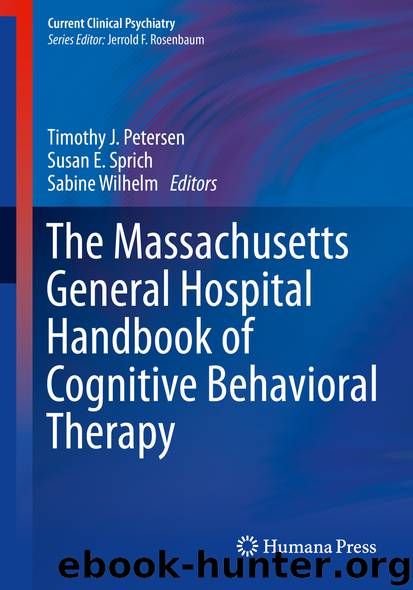The Massachusetts General Hospital Handbook of Cognitive Behavioral Therapy by Timothy J. Petersen Susan E. Sprich & Sabine Wilhelm

Author:Timothy J. Petersen, Susan E. Sprich & Sabine Wilhelm
Language: eng
Format: epub
Publisher: Springer New York, New York, NY
Shape checking and avoidance. Another way to reduce the influence of body shape and weight on self-evaluation is to reduce the behavioral manifestations of body image disturbance—shape checking and avoidance. Common shape checking behaviors include comparing one’s body to others, scrutinizing oneself in the mirror, pinching body parts for fatness, and repeatedly trying on special clothing. Avoidance behaviors can range from mild (e.g., sucking in one’s stomach to appear thinner, wearing baggy clothing to hide one’s shape) to severe (e.g., not showering or even leaving the house when “feeling fat”). Self-monitoring can help raise awareness and assess the frequency and extent of this behavior, and creative homework exposures (e.g., asking the patient to wear form-fitting clothes or focus on neutral parts of the body while looking in the mirror) can phase out avoidance behaviors.
Feeling fat. Patients with eating disorders often misattribute negative emotions or physical sensations related to fluctuations (real or imagined) in shape or weight. In actuality, such feelings of “fatness” are unlikely to be resolved by changing one’s shape or weight. The therapist can use in-session weighing to contrast large fluctuations in feelings of fatness with relatively modest fluctuations in weight. Additionally, self-monitoring can heighten the patient’s awareness of the context in which such feelings of “fatness” occur, to ascertain whether the patient is systematically misinterpreting feelings of sadness, loneliness, or anger as increased “fatness.”
Reducing dietary restriction. If patients persist in cutting out certain foods or minimizing caloric intake even in the context of establishing a pattern of regular eating, the therapist can assist the patient in designing behavior experiments to test hypotheses about the consequences of breaking dietary rules. For example, if a patient predicts that eating pizza will result in an immediate three-pound weight gain or trigger a certain binge, the therapist can assign the patient to eat a moderate portion of pizza in a safe environment where the patient is unlikely to binge (e.g., dinner with a friend) and compare weights from the session before and after.
Addressing event-related changes in eating. In Stage 3, the therapist should also assist the patient in identifying triggers for residual eating disorder behaviors, particularly low mood. Patients can then be encouraged to identify alternative pleasurable activities that distract from postprandial fullness or urge to binge (e.g., phoning a friend, reading a book, going for a leisurely walk). Similarly, patients can practice problem-solving skills to address interpersonal stressors (e.g., arguments with significant others) that give rise to restricting, bingeing, and purging.
Additional Stage 3 modules. Based on prior research and clinical observations about the likely characteristics of nonresponders, the full CBT-E manual includes modules for addressing additional potential maintaining mechanisms such as perfectionism, mood intolerance, core low self-esteem, and interpersonal difficulties. However, there is little evidence for the greater efficacy of the broad (versus focused) form of CBT-E [13]. Given that the focused version is likely to be appropriate for the vast majority of patients, we do not cover the supplemental modules here but rather refer the interested reader to the full CBT-E manual (i.e., Fairburn [11]) to learn more.
Download
This site does not store any files on its server. We only index and link to content provided by other sites. Please contact the content providers to delete copyright contents if any and email us, we'll remove relevant links or contents immediately.
Periodization Training for Sports by Tudor Bompa(8170)
Why We Sleep: Unlocking the Power of Sleep and Dreams by Matthew Walker(6618)
Paper Towns by Green John(5091)
The Immortal Life of Henrietta Lacks by Rebecca Skloot(4526)
The Sports Rules Book by Human Kinetics(4294)
Dynamic Alignment Through Imagery by Eric Franklin(4118)
ACSM's Complete Guide to Fitness & Health by ACSM(3989)
Kaplan MCAT Organic Chemistry Review: Created for MCAT 2015 (Kaplan Test Prep) by Kaplan(3940)
Introduction to Kinesiology by Shirl J. Hoffman(3726)
Livewired by David Eagleman(3684)
The Death of the Heart by Elizabeth Bowen(3552)
The River of Consciousness by Oliver Sacks(3541)
Alchemy and Alchemists by C. J. S. Thompson(3451)
Bad Pharma by Ben Goldacre(3357)
Descartes' Error by Antonio Damasio(3230)
The Emperor of All Maladies: A Biography of Cancer by Siddhartha Mukherjee(3068)
The Gene: An Intimate History by Siddhartha Mukherjee(3048)
The Fate of Rome: Climate, Disease, and the End of an Empire (The Princeton History of the Ancient World) by Kyle Harper(3003)
Kaplan MCAT Behavioral Sciences Review: Created for MCAT 2015 (Kaplan Test Prep) by Kaplan(2940)
